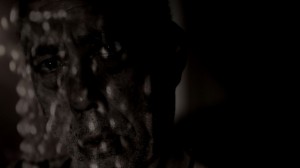-
Always Traveling in Music: Jards
by Aaron Cutler November 16, 2012
The old black man moves slowly. He’s seen a lot, you can tell, and you don’t need words to know it. The years, months, and days are folded into each of his wrinkles, standing out between his remaining gray-white wisps of hair, and weighing down his bent spine. But there’s a lightness in his step, and a casual grace about him that goes equally far beyond words. It’s as if he tells observers with each delicate shuffle that he’s been through so much already, and lasted; whatever else he undertakes, he’s going to be fine.
His name is Jards Anet da Silva, or Jards Macalé, and he was born in 1943 in Rio de Janeiro, where he still lives. He’s the focal point of the new documentary Jards, one of several rich discoveries at this year’s recently concluded edition of the São Paulo International Film Festival. He is also a musician—more precisely, a singer—who’s been recording since 1970. But if you don’t already know of him, then his first recording session in the movie is going to come as a shock.The sequence starts with a medium close-up of Jards wearing headphones, then moves in even closer to make his round face gigantic within the widescreen frame. The old man, mainly silent up to now, unleashes sound. It seems to stir up from within the bottom of his gut, course through his thin chest and veiny neck, and burst out of the gate of his mouth and teeth in the form of the words “Belo dia!” He calls the day beautiful through force of will.
As he keeps singing, the camera turns shakily around him. Bright light bursts in to cover him, and he moves in and out of focus until clarity is finally reached. The left-hand side of the frame stays empty throughout, as though waiting for someone—perhaps us, perhaps somebody else—to step in. His lips contort to sculpt the shapes of each subsequent word; for Jards, language is raw material for creation as well as for communication. By the end of his song, the sun’s come out, the world’s been formed again, and—if it hasn’t happened already—we’re exhausted, energized, alert, and just a little more awake.
The film Jards, in which our hero records a new album, is about discovering how many different ways exist of hearing and seeing a person, as well as how many different angles exist to watch him from. The director Eryk Rocha (no coincidence—son of Glauber) has worked largely as a portraitist in his previous films, all documentaries save for the recent fiction-doc hybrid Passerby (2010), a black-and-white following of a quiet old man over the course of a day throughout Rio. (Passerby received its American premiere this year at the Museum of Modern Art’s series Premiere Brazil!; Jards has yet to play Stateside.)
Here he presents his human subject through a variety of styles and shooting formats. While in the musical sequences Jards almost invariably appears in high-res color HDCam images, the qualities of the quiet, solitary interludes between them vary greatly. Sometimes Jards, sitting on the veranda of his beach house or walking alone as waves crash impressionistically around him, is seen in color, sometimes in black-and-white. Sometimes he is shot from an outsider’s observational view in full curved figure; at other moments, it’s as if you’re seeing the air vibrate blurrily through his bespectacled eyes. Sometimes, without explanation or transition, the grainy, tattered, film images captured during his youth run onscreen, as a jovial young man parties with friends in an alleyway. These are moments of downtime, allowing space for reflection. Each different style, we sense, reflects a different part of Jards’ head—long-bubbling introspection and brief, immediate joy, distorting darkness, distending radiance. They all come together with force and energy when he sings.
Early on Jards looks up his own song lyrics on Google. Later, his in-process recordings of his greatest hits will receive accompaniment from special guest stars such as Luiz Melodia, Frejat, and Thais Gulin, each of whom fills the once-empty frame space in order to duet with him. The film doesn’t need to generate suspense or even much of a narrative, because it’s a register of a moment. The handheld camera captures procedural details—the way a finger plays a chord or a key, the way a tongue lifts a note—to give an unusually intimate look at how music is made collaboratively, sound by sound.
Throughout, Jards gives the sense of artistic creation bringing a life into focus. This sense carries over from the recording sessions to the listening booth and other studio spaces, where the producers and players lounge and laugh when they’re not debating where to go next. Jards moves among them, seemingly cheerful. He doesn’t need to say what he’s thinking, because his T-shirt, which reads “always traveling in music,” might already.





